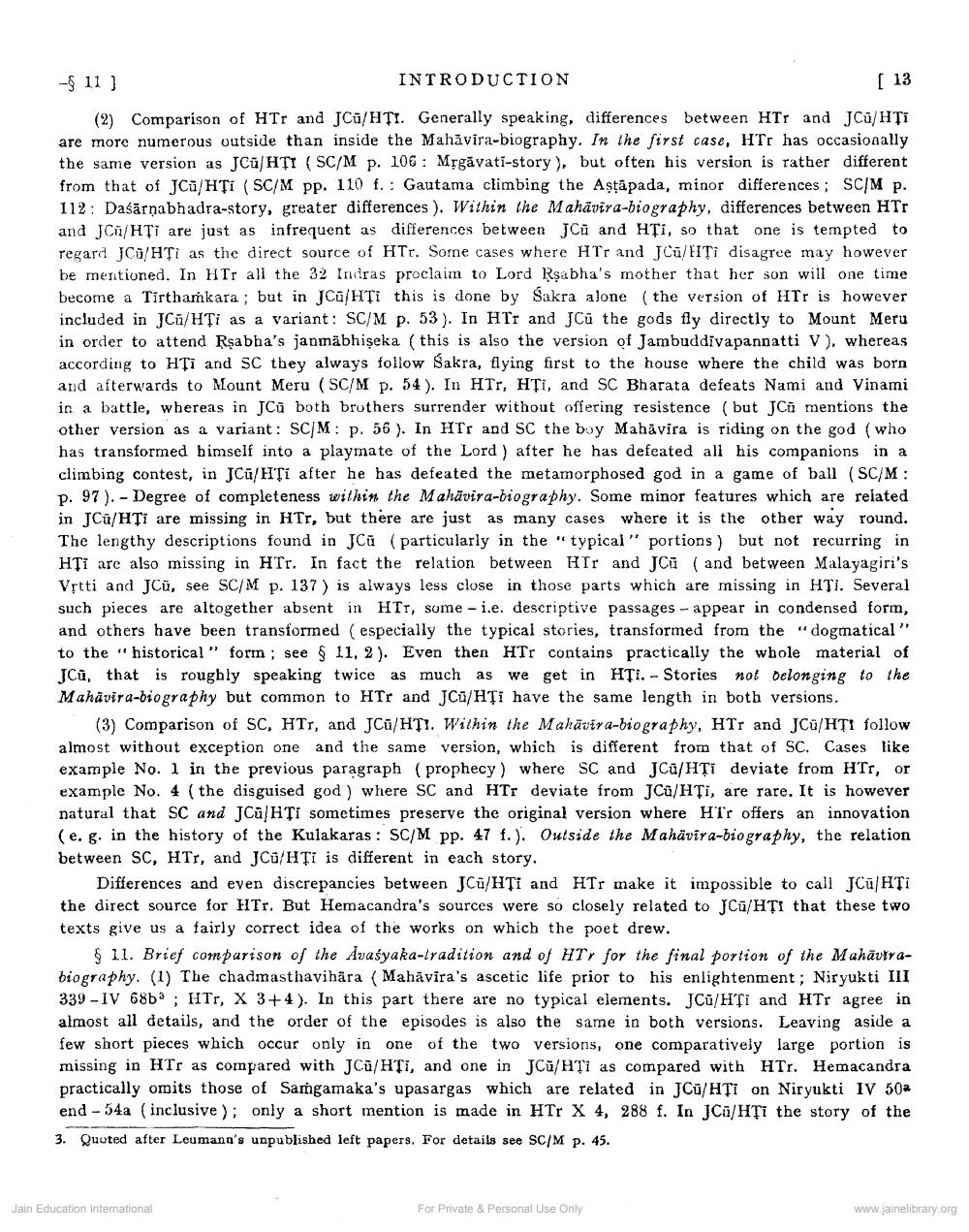________________
-§ 11 ]
[ 13
(2) Comparison of HTr and JCu/HTI. Generally speaking, differences between HTr and JCũ/HŢI are more numerous outside than inside the Mahavira-biography. In the first case, HTr has occasionally the same version as JCu/HTI (SC/M p. 106: Mṛgavati-story), but often his version is rather different from that of JC/HŢI (SC/M pp. 110 f.: Gautama climbing the Aṣṭapada, minor differences; SC/M p. 112: Daśārṇabhadra-story, greater differences). Within the Mahavira-biography, differences between HTr and JC/HTI are just as infrequent as differences between JCu and HŢi, so that one is tempted to regard JC/HTI as the direct source of HTr. Some cases where HTr and JCu/HTi disagree may however be mentioned. In HTr all the 32 Indras proclaim to Lord Rṣabha's mother that her son will one time become a Tirthamkara; but in JCu/HTI this is done by Sakra alone (the version of HTr is however included in JC/HŢi as a variant: SC/M p. 53). In HTr and JCù the gods fly directly to Mount Meru in order to attend Rṣabha's janmābhiṣeka (this is also the version of Jambuddivapannatti V), whereas according to HTI and SC they always follow Sakra, flying first to the house where the child was born and afterwards to Mount Meru (SC/M p. 54). In HTr, HŢi, and SC Bharata defeats Nami and Vinami in a battle, whereas in JCu both brothers surrender without offering resistence (but JCu mentions the other version as a variant: SC/M: p. 56). In HTr and SC the boy Mahavira is riding on the god (who has transformed himself into a playmate of the Lord) after he has defeated all his companions in a climbing contest, in JCu/HŢi after he has defeated the metamorphosed god in a game of ball (SC/M: p. 97). Degree of completeness within the Mahavira-biography. Some minor features which are related in JCu/HŢi are missing in HTr, but there are just as many cases where it is the other way round. The lengthy descriptions found in JCu (particularly in the "typical" portions) but not recurring in HTI are also missing in HTr. In fact the relation between HIr and JCũ (and between Malayagiri's Vṛtti and JCü, see SC/M p. 137) is always less close in those parts which are missing in HTI. Several such pieces are altogether absent in HTT, some - i.e. descriptive passages - appear in condensed form, and others have been transformed (especially the typical stories, transformed from the "dogmatical" to the historical" form; see § 11, 2). Even then HTr contains practically the whole material of JCu, that is roughly speaking twice as much as we get in HTI. - Stories not belonging to the Mahavira-biography but common to HTr and JC/HŢi have the same length in both versions.
INTRODUCTION
(3) Comparison of SC, HTr, and JCu/HTI. Within the Mahavira-biography, HTr and JCu/HTI follow almost without exception one and the same version, which is different from that of SC. Cases like example No. 1 in the previous paragraph (prophecy) where SC and JCu/HȚi deviate from HTT, or example No. 4 (the disguised god) where SC and HTT deviate from JCü/HTi, are rare. It is however natural that SC and JCu/HTI sometimes preserve the original version where HTr offers an innovation (e. g. in the history of the Kulakaras: SC/M pp. 47 f.). Outside the Mahavira-biography, the relation between SC, HTr, and JCG/HTI is different in each story.
Differences and even discrepancies between JCu/HTI and HTr make it impossible to call JC/HTI the direct source for HTr. But Hemacandra's sources were so closely related to JCu/HTI that these two texts give us a fairly correct idea of the works on which the poet drew.
§ 11. Brief comparison of the Avatyaka-tradition and of HT for the final portion of the Mahatrabiography. (1) The chadmasthavihāra (Mahavira's ascetic life prior to his enlightenment; Niryukti III 339-IV 68b; HTr, X 3+4). In this part there are no typical elements. JCu/HTI and HTr agree in almost all details, and the order of the episodes is also the same in both versions. Leaving aside a few short pieces which occur only in one of the two versions, one comparatively large portion is missing in HTr as compared with JCu/HTI, and one in JCu/HT as compared with HTr. Hemacandra practically omits those of Samgamaka's upasargas which are related in JCu/HTI on Niryukti IV 50a end - 54a (inclusive); only a short mention is made in HTr X 4, 288 f. In JCa/HŢi the story of the 3. Quoted after Leumann's unpublished left papers. For details see SC/M p. 45.
Jain Education International
For Private & Personal Use Only
www.jainelibrary.org




